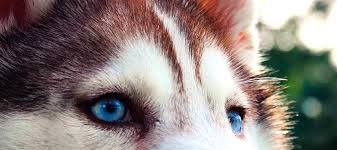
Vet expenses can be very high, especially if any type of operation or specialist care is involved. Ensure that your pet is covered in the event of any unexpected, and unforeseen accidents, any operations, or perhaps diseases or conditions that may develop, and of course to look after your Golden Oldie, when those days arrive. We have 5 simple plans for comprehensive pet insurance coverage. Visit our website at https://genricpet.co.za/
Why Do Husky Dogs & Some Other Breeds Have Blue Eyes?
by Juliana Weiss-Roessler
www.dogcare.dailypuppy.com
by Juliana Weiss-Roessler
www.dogcare.dailypuppy.com
While looking for information on this subject we came across the following based on recent research by The Genetic Literacy Project which you may find interesting and may want to follow up on:-
Alex Barasch - The research is the first of its kind to be conducted in nonhumans. It drew on data from more than 6,000 customer dogs in an effort to identify the genetic mutation responsible for blue eyes, a striking trait that’s relatively common in Siberian huskies but rare among other breeds in which it sometimes appears, like border collies and corgis.
"The data allowed them to identify a novel association"with regard to dogs with blue eyes: An allele on chromosome 18, carried by just 10 percent of dogs in the data set overall, was present in 100 percent of blue-eyed Siberian huskies.
Alex Barasch - The research is the first of its kind to be conducted in nonhumans. It drew on data from more than 6,000 customer dogs in an effort to identify the genetic mutation responsible for blue eyes, a striking trait that’s relatively common in Siberian huskies but rare among other breeds in which it sometimes appears, like border collies and corgis.
"The data allowed them to identify a novel association"with regard to dogs with blue eyes: An allele on chromosome 18, carried by just 10 percent of dogs in the data set overall, was present in 100 percent of blue-eyed Siberian huskies.
Brown is the most common eye color for dogs, but many Siberian Huskies have striking blue eyes. They can also have brown eyes, one eye that is blue and one that is brown, or blue and brown coloring in both eyes. The color of their eyes is controlled by a rare gene that few dog breeds are believed to have.
Potential Causes of Blue Eyes in Dogs
Siberian Huskies aren’t the only dogs with blue eyes. Several factors can cause blue eyes in various dog breeds. Usually, though, blue coloring is due to a gene that dilutes the pigmentation of the dog’s coat and eyes. Dogs who have the merle gene, such as Australian shepherds and Weimaraners, may have light blue eyes as a result of a random loss of pigmentation caused by the gene. This loss of pigmentation also leads to a white or light-colored coat on the face. Siberian Huskies are among the only breeds that can have blue eyes completely independent of the merle gene.
The Genetics of Blue Eyes in Huskies
Siberian Huskies have a specific gene that causes a loss of pigmentation in the irises but not the coat, which is why Huskies can have dark coats and blue eyes. This gene allows their eyes to range in color from very light blue to very rich blue. This particular gene is rare. While some breeders believe it can cause blue eyes in border collies, too, it is primarily seen in the Siberian Husky breed.
Possible Eye Color Combinations
Huskies can have a wide range of eye colors, including blue, brown, hazel and amber. Dogs with one blue and one brown eye are called bi-eyed, while dogs that have blue eyes flecked with brown, or vice versa, are known as parti-eyed or split-eyed. Some Huskies with parti-eyes will look like they have pie-shaped wedges of brown coloring in eyes that are otherwise blue. These mixed color combinations are relatively common. All of these eye colors are accepted by the American Kennel Club.
Husky Puppies’ Eye Color May Change
Husky puppies first open their eyes when they are about 2 weeks old. All Husky puppies’ eyes initially appear to be blue, but there's no guarantee their eyes will still be blue as adults. Their eyes will often change color as late as age 4 weeks or 5 weeks. This shouldn’t be a major concern for dog owners, as no eye color is associated with any particular health problems, and all colors are permissible in the conformation ring.
Potential Causes of Blue Eyes in Dogs
Siberian Huskies aren’t the only dogs with blue eyes. Several factors can cause blue eyes in various dog breeds. Usually, though, blue coloring is due to a gene that dilutes the pigmentation of the dog’s coat and eyes. Dogs who have the merle gene, such as Australian shepherds and Weimaraners, may have light blue eyes as a result of a random loss of pigmentation caused by the gene. This loss of pigmentation also leads to a white or light-colored coat on the face. Siberian Huskies are among the only breeds that can have blue eyes completely independent of the merle gene.
The Genetics of Blue Eyes in Huskies
Siberian Huskies have a specific gene that causes a loss of pigmentation in the irises but not the coat, which is why Huskies can have dark coats and blue eyes. This gene allows their eyes to range in color from very light blue to very rich blue. This particular gene is rare. While some breeders believe it can cause blue eyes in border collies, too, it is primarily seen in the Siberian Husky breed.
Possible Eye Color Combinations
Huskies can have a wide range of eye colors, including blue, brown, hazel and amber. Dogs with one blue and one brown eye are called bi-eyed, while dogs that have blue eyes flecked with brown, or vice versa, are known as parti-eyed or split-eyed. Some Huskies with parti-eyes will look like they have pie-shaped wedges of brown coloring in eyes that are otherwise blue. These mixed color combinations are relatively common. All of these eye colors are accepted by the American Kennel Club.
Husky Puppies’ Eye Color May Change
Husky puppies first open their eyes when they are about 2 weeks old. All Husky puppies’ eyes initially appear to be blue, but there's no guarantee their eyes will still be blue as adults. Their eyes will often change color as late as age 4 weeks or 5 weeks. This shouldn’t be a major concern for dog owners, as no eye color is associated with any particular health problems, and all colors are permissible in the conformation ring.





